|
| Rosie owned by Allyse M. |

|
WHITES
Can range from the ice white to the creamy white. Some whites can even be born with light
apricot colored ears. Whites should have black points.
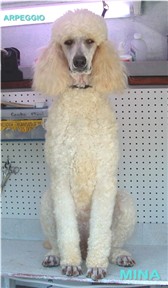
CREAMS
Can be as light as to be almost white to the buttery
cream color. All creams should have black points.
Sometimes you will hear a old time breeder call a
puppy champagne in color. This used to be a color that AKC accepted. It is now lumped in with the creams.
NOTE: You can also have combinations of
white & cream on a solid colored puppy. This is usually a base color of white with cream highlights or tipping.

APRICOT
Is a dilute of red. It carries the fadding gene.
Apricots can be as light as to look cream but should have more of a red cast to them than the creams do. Some apricots
can be almost burnt umber in color or orangey. Apricots should have black points. Liver points are acceptable
but not prefered.
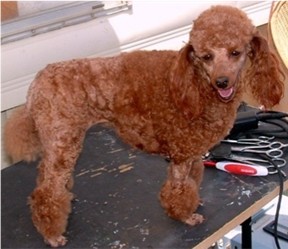
RED
Can be as light as to be almost apricot to a dark mahogany color. It is commonly thought to
be a fadding color, meaning it carries the fadding gene also. Red should have black points. Liver points are acceptable
but not prefered.

RED/APRICOT
Is a combination of red and apricot on a solid colored puppy. This is a puppy that is usually
lighter than red and has highlights of apricot or apricot tipping. Almost a swirling combination of red and apricot.

BROWN
Can be so dark as to look black or have a more reddish brown shade to them (chestnut). Browns
should not be confused with Cafes or Silver Beiges. For these are shades of browns that fade. A true brown
should never fade. However because most browns DO fade, it too is commonly thought to be a fading color. Browns
must have liver points and dark amber eyes.

CAFE AU LAIT
Is a dilute of brown. It carries the fadding gene. Think of them as coffee with cream
added. They are born dark brown and change to cafe around the age of 2 yrs. Not to be confused with silver beige.
Cafes must have liver points and dark amber eyes. A beige colored puppy at birth is NOT a cafe au lait!

SILVER BEIGE
Must be born brown. It is a dilute of brown. It carries the fadding gene also.
They will lighten with age just as a silver would. There are various shades of silver beige. Sometimes they turn
almost platinum silver with a huge of brown to them. A silver beige must be silvering in the face and feet by the
age of 6 weeks to be a silver beige. They must have liver points and dark amber eyes.
For more information on silver beige please see our poodle coat colors 2 page.
| Chewie owned by Mike M. |
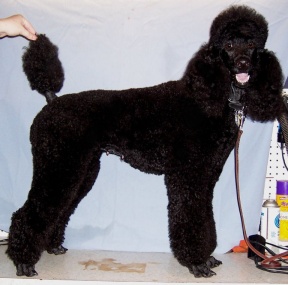
|
BLACK
Should be a beautiful deep jet black. WIth no hint of blue or silver in it. The face
when shaved should be almost, if not as dark, in color as the main coat. A true black should never fade.
They should never have white or silver guard hairs. Blacks must have black points and dark brown eyes.
For more information please visit our poodle coat colors 3 page.
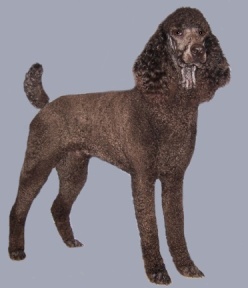
BLUE
Is a dilute of black. It carries the fadding gene. Blue puppies are born
black and turn blue by two years of age. Blues take the longest time to clear. Puppies at a young age will have
brown highlights showing they are a blue not black puppy. By 2 years of age the dog will turn a dark gun metal gray.
There are varing shades of blue as in any color. Blue should have black points and dark brown eyes. For more information
please visit our poodle coat colors 3 page.
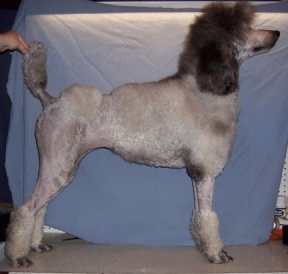
SILVER
Is a dilute of black. It also carries the fadding gene. Silvers are born black and clear
over time. Silvers should have silver face and feet by the age of 6 weeks to be a silver. There are varing shades
of silver to a sparkling platinum that is almost white to a beautiful pewter color. Silvers must have black points and
dark brown eyes. For more information on silvers please visit our poodle
coat colors 2 page.
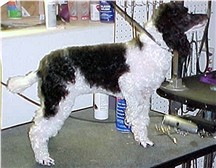
PARTI COLORED
(Piebald) At least fifty percent white, with spots or patches of any other acceptable solid color.
The head can be of a solid color but white muzzle, blaze, or white muzzle/blaze combination (preferably symmetrical) are equally
acceptable. Full or partial saddles are acceptable, as long as they do not exceed the color proportion, but are not preferred.
Ticking in the white of the coat is acceptable but not preferred.

PHANTOM
Solid base color with sharply
defined markings of a second color appearing above each eye, on the sides of the muzzle, on the throat and forechest, or in
a chin and forechest bowtie pattern as well as on all four legs and feet, and below the tail. A phantom without clearly defined
face markings or one that presents with its whole face colored in the second color is acceptable, as long as it maintains
all the other specified body markings. Any combination of acceptable colors is allowed.

ABSTRACT
(otherwise know as a mismark): Less than fifty percent white, with the remaining percent any other
acceptable solid color. Many breeders mistakenly call these abstracts tuxedos. They are however NOT true tuxedos.
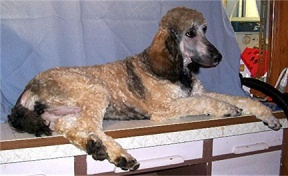
SABLE
A coat represented by black-tipped hairs on a background of any solid color, with no particular
pattern/location designated for such hairs.
For more on Sables please visit our poodle coat colors 4 page.
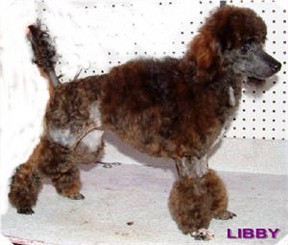
BRINDLE
A coat that exhibits a tiger-striped pattern resulting from layered black hair intermingled in areas
of lighter color: ie: lighter color with black stripes. Reverse brindle occurs when the black striping is so heavily
concentrated that the lighter background, while clearly still present, is much more subdued, giving the appearance of the
coat being black in color with lighter stripes.
For more on Brindles please visit our poodle coat colors 4 page.
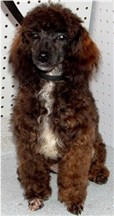
MULTI-PATTERNED
A dog that clearly exhibits more than one of the acceptable color patterns, such as; a Parti with
full or incomplete phantom markings (facial markings with or without presentation of the diamond under the tail), or a Phantom
with additional abstract markings, A brindle with abstract markings, a parti with brindle spots, etc.
| Paige owned by Leslie of Frenchies Poodles |

|
TRUE TUXEDO
A very heavily marked parti and where as they are usually less than 50% white they are still
concidered a parti and are produced by partis. Tuxedos will usually have a white bib that may or may not go all the
way around the neck, they usually have an all white belly. The white will usually extend from the elbows down to the
feet and from the hock to the rear foot. However you can have some variation in this with one or two legs not having
any white at all. You may or may not see markings on the head.
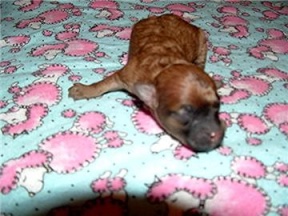
MASKING
You can often have poodle born with either black or white masking on the faces. This is not
to be mistaken with the markings of a phantom. These masked poodles do not have the seperated eyebrows nor the body
markings of a phantom. Most times as a puppy with a mask matures and the face is shaved the mask will gradually disappear.
Which would leave many thinking that the mask has something to do with the sable gene and that the masking is only tipping
on each individual hair shaft.
MERLE
The merle gene has NOT been found to be carried by poodles. That means that the merle gene
had to be introduced into the poodle via another breed of dog. Whereas these dogs are very striking in color, they are
highly suspect as to the purity of their breeding. It is a color that I would highly recommend staying away from.
If you will notice these "merle poodles" are NOT registered through the AKC or UKC. This is probably due to their being
a lot of questions when it came to having them DNA'd. No picture available.
|